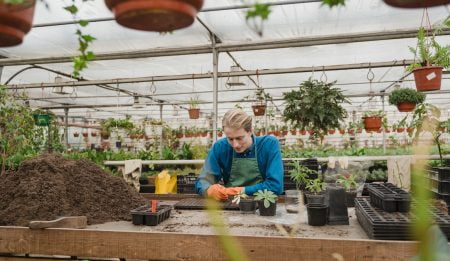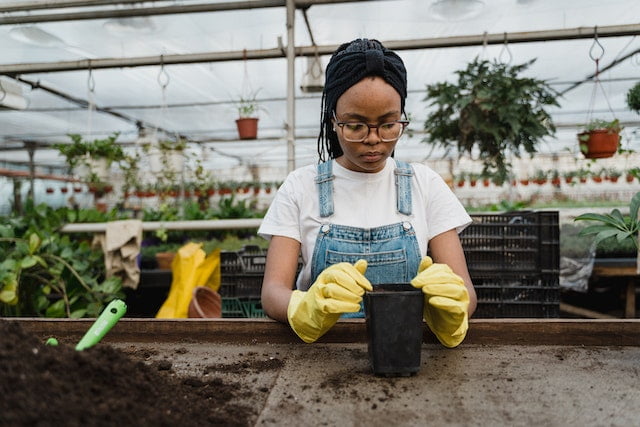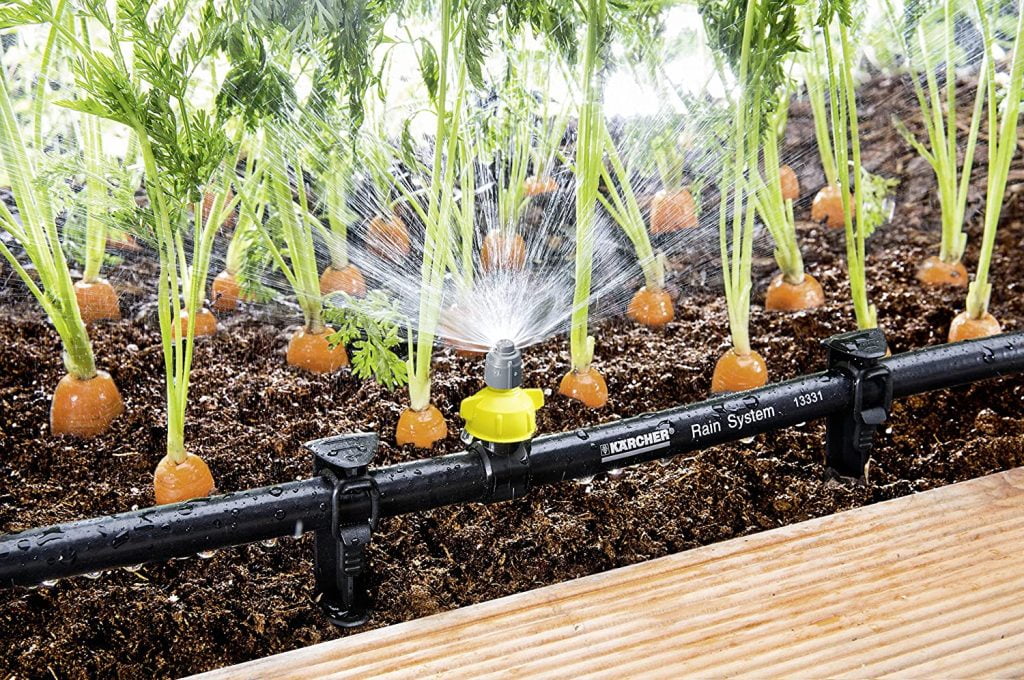Roof gardens are a concept that has been introduced previously. The history of roof gardens can be seen even in very ancient civilizations. Urbanization is increasing worldwide and urban agriculture is gaining popularity day by day due to the impact of urbanization. Apart from meeting family nutritional needs, this agriculture sector has become important commercially. There are essential steps in setting up a roof garden. Such as roof garden planning; a collection of materials; soil preparation; Filling the tub with soil; and Plant Selection These issues are discussed below.
What Is Roof Garden?
A rooftop garden is a garden created by making beds on the bare rooftop of a house or by growing in tubs or drums. An aesthetic garden can be developed on the rooftop of any residential, or commercial building or factory made of bricks.
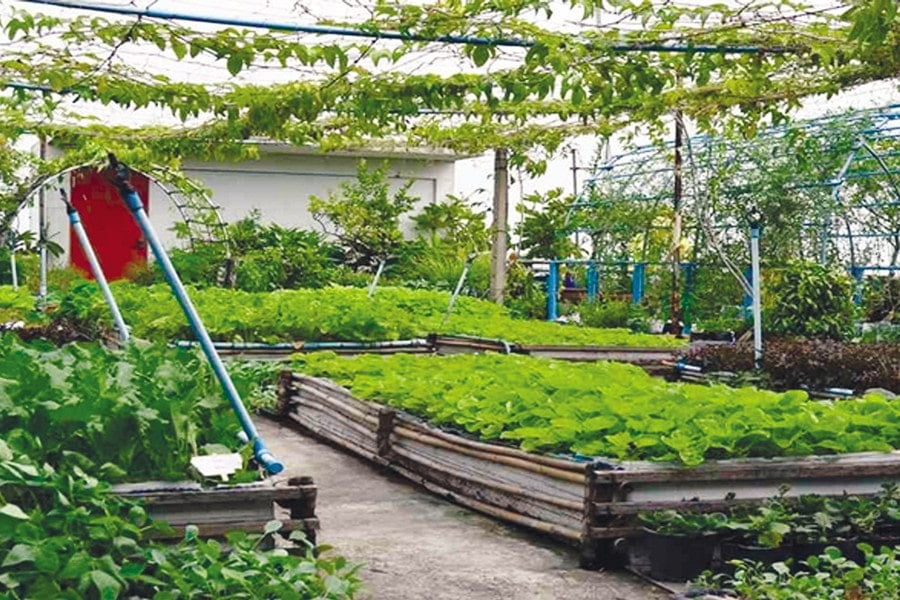
A Roof Garden.
Just as flowers and ornamental trees can be planted in the roof garden, various horticultural crops including fruits, vegetables, spices, and medicinal plants can also be cultivated. By doing this, fresh and safe food can be provided on the one hand, on the other hand, cool shade, animal shelters, play, and entertainment spaces can be ensured even in the urban mechanized life.
Plan:
Rooftop gardening requires a mental solid preparation and there is no substitute for proper planning to enhance the beauty and good production of roof gardens. Before setting up a rooftop garden, you must think about whether the rooftop of your house is suitable for gardening or not. That is, is the top strong enough to bear the weight of the plants? Is the drainage system good? Better to plan and design yourself. But can also be designed by landscape horticulturists.
How To Design a Roof Garden?
- In planning and designing the family rooftop garden, a design should be taken in pencil according to the size and volume of the rooftop. The design should determine the perimeter and dimensions of the roof.
- Some open space should be kept for ease of movement. If the size of the roof is large, the roof should be divided into several parts and a passage of about 1 to 1.5 meters should be kept between each part.
- Now start planning and drawing the design from any edge of the roof.
- In each part of the interior, a structure or a tub should be marked for placing or planting one type of plant. The water source must be included in the design.
- If you want to garden, you also need a place to store some things. So the store room should be kept in the design.
- It is better to plant fruit trees in the middle of the roof to increase the beauty.
- If you think of climbing some creepers on the roof’s edge, it is better to attach some iron clamps or hooks on the inside or outside of the grill or railing on the roof railing.
- Sunlight is essential for the survival of any plant. So while making the design of the garden, from which side the sun comes from the rooftop and in which direction the sun moves according to the season, etc. should be taken care of.
- There should be a proper plan for the drainage of excess water.
- A lawn and a sitting shed can also be constructed in the open area to enhance the beauty of the roof, but the size of the shed should fit the roof.
Materials Required:
Various tools used for roofing a garden should be kept in the collection like a spade, garden fork, budding knife, secateurs, pruning shears, saw, balance, dibbler, watering can, etc.
Containers include trays, seed pans, pots, plastic pots, growing bags, buckets, polybags, drums, half drums, soil bowls, etc.
How To Prepare The Soil For The Roof Garden?
The success of growing plants in tubs/pots depends largely on the preparation of the soil mixer. So the following points are very important:
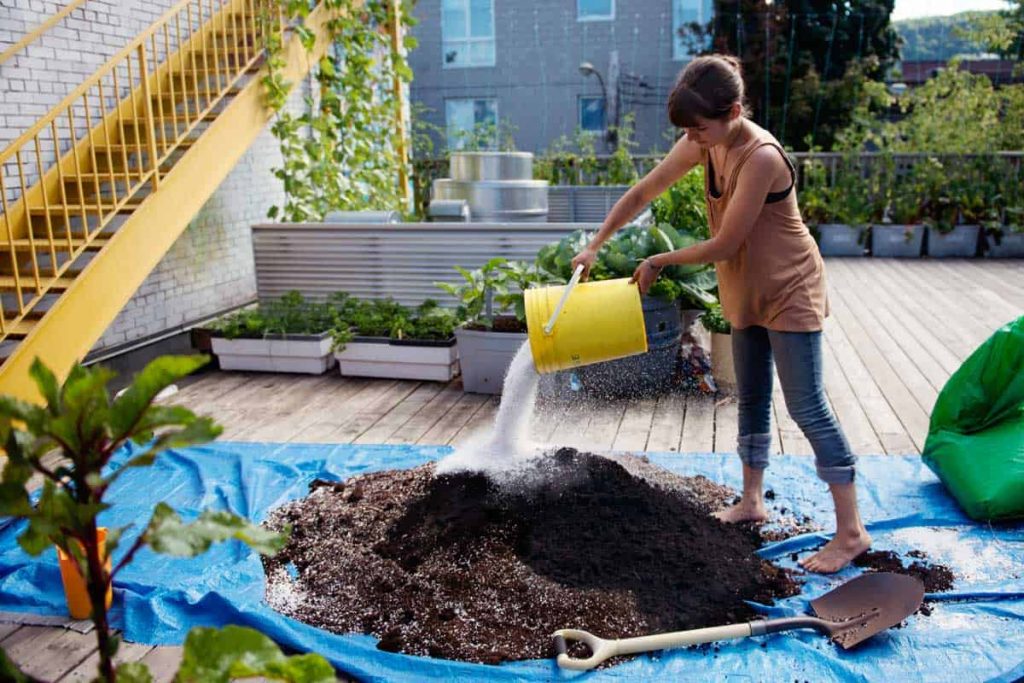
Prepare The Soil For The Roof Garden.
- By pulverizing the soil, the unwanted matter should be removed from the soil.
- Take the required amount of soil, mix it with dolomite at the rate of 0.5 gm (if soil pH is more than 5) / 1 gm (if soil pH is less than 5) per kg soil, wrap it in polythene for 8-10 days.
- Urea, TSP, and MOP at the rate of 0.5 gm should be added to the treated soil by mixing the quantity of dung and coco peat per kg of mixture.
- soil: Compost: Coco peat mixture should be given in the ratio of 2:1:1.
How To Fill The Soil in The Tub For Roof Garden?
- Three to four holes should be kept at the bottom of the tub to drain excess water from the tub.
- The bottom of the tub should be covered with 2/3 cm thick bricks, if this is not possible, then 3 or 4 pieces of broken tubs or brick pieces should be covered over the holes so that the holes are not blocked by soil.
- While filling the tub with soil, 0.5 to 1 inch on the top of the tub and 1.0 to 1.5 inch in the case of half drum should be kept free for proper application of fertilizer and water. Fill the tub/pot up to the specified height with soil mixed with manure.
- After leaving the filled pot for 12-15 days, seedlings/seeds should be sown.

Fill The Soil in The Tub For Roof Garden.
Selection of Plants For Roof Garden:
- Trees should be selected for roof gardens, which have short varieties, and shallow root depths, and bear fruit throughout the year.
- Fruits suitable for roof gardens are hybrid mango, apple, avocado, guava, hybrid papaya, Thai mango, citrus fruit, strawberry, dragon fruit, pear, etc.
- Different types of vegetables can be planted. For example, red cabbage, spinach, capsicum, lettuce, brinjal, tomato, shim, bitter gourd, gourds, etc.
- Various flowers for beauty and peace of mind such as – rose, Belli, jasmine, myrrh, gerbera, Alamanda, etc.
- Spices and medicinals such as chilies, coriander leaves, mint, curry leaves, onions, garlic, aloe vera, tulsi, thankuni, etc. can be planted.

Selection of Plants For Roof Garden
Irrigation And Water Management:
The most important aspect of roof gardens is irrigation management. The success of garden establishment depends on regular moderate irrigation. Watering too much is harmful to plants as well as under-watering. Due to over-watering, various diseases can be seen in tub/potted plants and even plants/seedlings die. For this reason, water can be given only when the root of the plant is dry, if the root is wet, no water can be given. Care should be taken during the rainy season if water accumulates at the roots of beans, chilies, brinjals, etc., water must be drained quickly otherwise it will be affected by waterlogging diseases. Once a roof tree is infected with downy mildew, good yield cannot be expected from it. It is better to water the garden in the morning and afternoon except during the monsoon, but in summer it must be watered in the morning and afternoon.
While giving water during summer, care must be taken that the pipe water is not hot. Avoid watering to prevent wilting. The amount of water should be given less when the plant flowers, but a small amount of water should be given regularly at the base, otherwise, the flowers of the roof garden will drop due to lack of water.
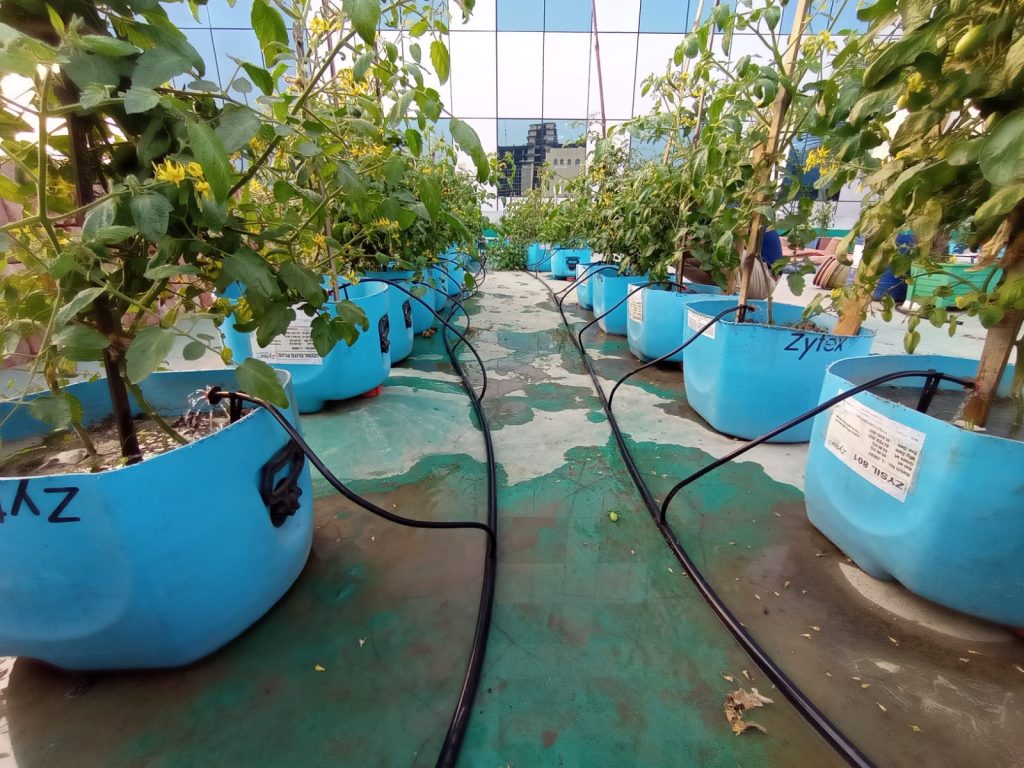
Irrigation And Water Management in The Roof Garden.
Cucurbits must be irrigated properly, otherwise, the desired growth and good yield will not be achieved. Drip irrigation is a very useful method for roof gardens. Drip irrigation is a method by which water can be applied at a precise and balanced rate to the root of the plant. Apart from this, water-soluble fertilizers can be applied to plants in the proper amounts. Drip irrigation is a very timely and necessary technology. In this method, drip irrigation is done at the root of the plant with the help of perforated pipes, there is no wastage of water. This method is very effective where water for irrigation is scarce.
The Best Fertilizer Management System For Roof Gardens:
Adequate care should be taken regarding the application of fertilizers in roof gardens. A small amount of fertilizer should be sprayed every two (2) weeks.
1st stage
5 grams of urea, 5 grams of TSP, and 1-2 grams of boron fertilizer should be mixed well in 1 liter of water (in that case it is better to soak TSP fertilizer 3/4 hours before).
2nd stage
5 grams of urea and 5 grams of zinc should be mixed in 1 liter of water (2 weeks after the 1st time).
3rd stage
Mix 5 gm Urea and 2-3 gm MOP fertilizer in 1 liter of water (2 weeks after 2nd time), in the case of seedlings/small plants, can be applied at 4/5 plant root, in the case of the big plant (if in the big tub) 2 plant root application Can go, again in the half drum can be applied to 1 tree trunk.
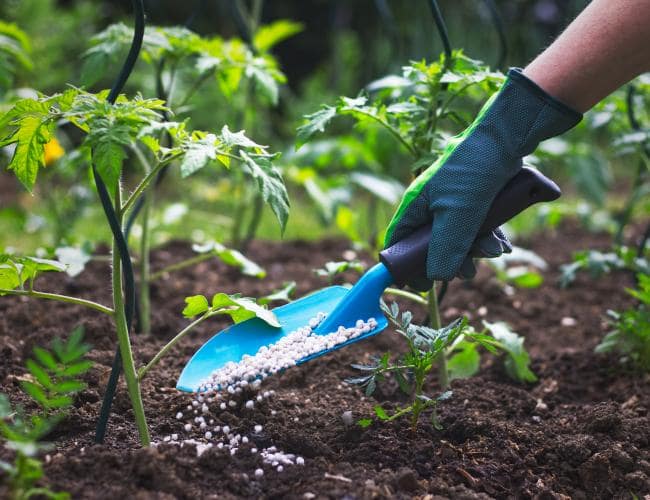
Fertilizer Management System For Roof Garden.
In this way, a small amount of fertilizer applied in a rotational manner will give a good yield in the roof garden. It is better to apply water mixed with fertilizer in the fall afternoon, but the amount of water mixed with fertilizer should be applied to the soil at the base of the plant so that the soil at the base dries up the next day. Irrigation should be done in such a way that excess water does not accumulate at the base of the plant during monsoon. The use of organic fertilizers in roof gardens is best.
Other General Management:
Crops like cucurbits require hand pollination to prevent pollination problems. Whiteflies, jab beetles, fruit flies, tip and stem borers, leaf miners, etc. are very common in roof gardens. In order to control them, pheromone traps should be used properly, along with spraying a moderate amount of neem oil soapy water, or other organic pesticides.
Conclusion
creating a garden on your rooftop can be a rewarding and fulfilling project. Not only does it add beauty and greenery to your home, but it can also provide you with fresh herbs, vegetables, and flowers. With a little bit of planning and effort, you can turn your rooftop into a thriving oasis. Whether you’re a seasoned gardener or a beginner, there are plenty of resources available to help you get started. So why wait? Start planning your roof garden today and enjoy the benefits of growing your own plants in an urban setting.
You Can Read About Dragon fruit farming in the roof garden.
I am Gaushoul Agam
𝐂𝐨-𝐅𝐨𝐮𝐧𝐝𝐞𝐫 & 𝐂𝐄𝐎
ToAgriculture
I am an experienced Horticulture Officer in the Department of Agricultural Extension in Bangladesh. I am committed to improving agriculture and farming.
I created ToAgriculture to address global food safety concerns. These concerns are caused by a growing population, diminishing farmland, and the impact of climate change on agriculture. I assist readers in learning modern farming techniques.
I also help them control pests and diseases. Additionally, I guide managing agriculture sustainably. All of this is aimed at creating a better and more successful future in farming.
I have experience in field crops and horticulture crops. I know about fruit and vegetable farming, managing pests and diseases, irrigation, and grafting. Come with me as I share my knowledge and experiences to help you create a better future.
